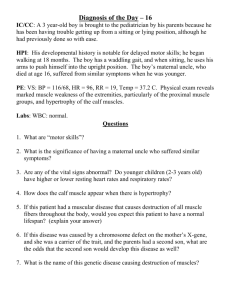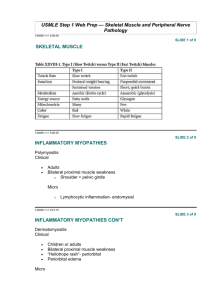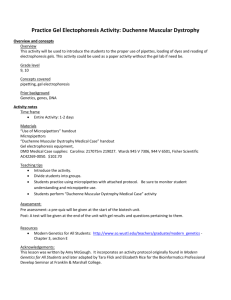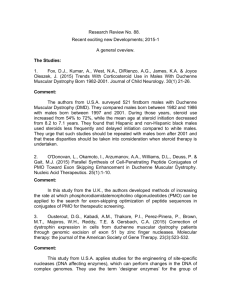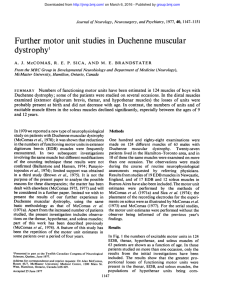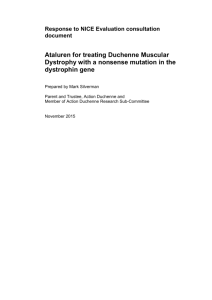Neurological Muscular Diseases
advertisement
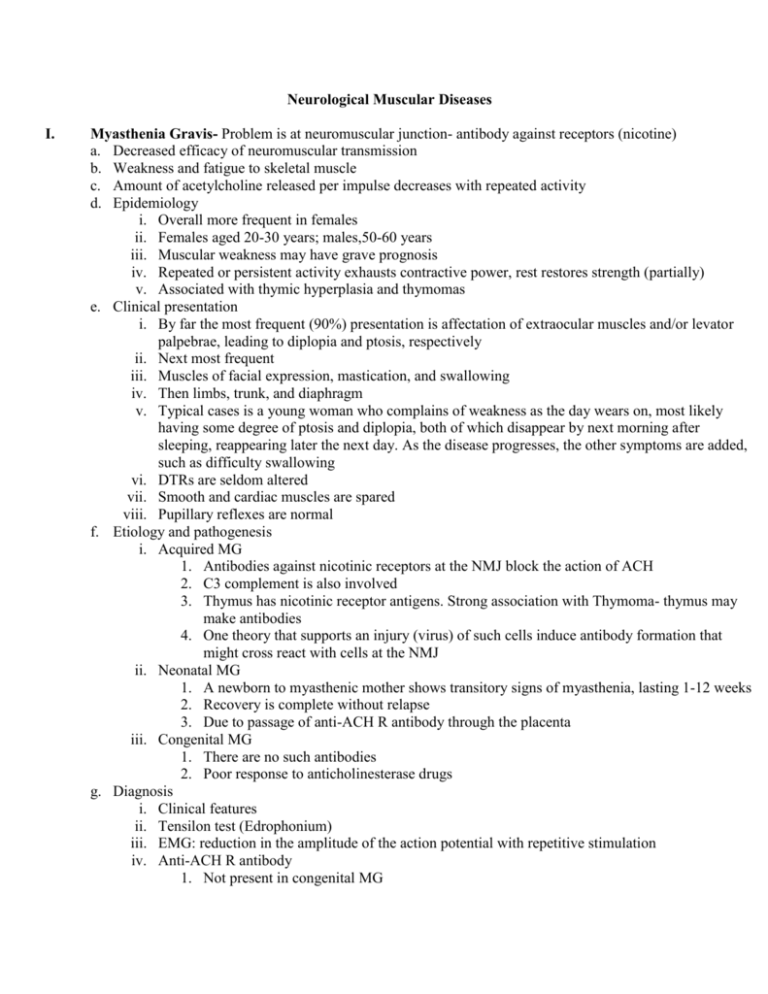
Neurological Muscular Diseases I. Myasthenia Gravis- Problem is at neuromuscular junction- antibody against receptors (nicotine) a. Decreased efficacy of neuromuscular transmission b. Weakness and fatigue to skeletal muscle c. Amount of acetylcholine released per impulse decreases with repeated activity d. Epidemiology i. Overall more frequent in females ii. Females aged 20-30 years; males,50-60 years iii. Muscular weakness may have grave prognosis iv. Repeated or persistent activity exhausts contractive power, rest restores strength (partially) v. Associated with thymic hyperplasia and thymomas e. Clinical presentation i. By far the most frequent (90%) presentation is affectation of extraocular muscles and/or levator palpebrae, leading to diplopia and ptosis, respectively ii. Next most frequent iii. Muscles of facial expression, mastication, and swallowing iv. Then limbs, trunk, and diaphragm v. Typical cases is a young woman who complains of weakness as the day wears on, most likely having some degree of ptosis and diplopia, both of which disappear by next morning after sleeping, reappearing later the next day. As the disease progresses, the other symptoms are added, such as difficulty swallowing vi. DTRs are seldom altered vii. Smooth and cardiac muscles are spared viii. Pupillary reflexes are normal f. Etiology and pathogenesis i. Acquired MG 1. Antibodies against nicotinic receptors at the NMJ block the action of ACH 2. C3 complement is also involved 3. Thymus has nicotinic receptor antigens. Strong association with Thymoma- thymus may make antibodies 4. One theory that supports an injury (virus) of such cells induce antibody formation that might cross react with cells at the NMJ ii. Neonatal MG 1. A newborn to myasthenic mother shows transitory signs of myasthenia, lasting 1-12 weeks 2. Recovery is complete without relapse 3. Due to passage of anti-ACH R antibody through the placenta iii. Congenital MG 1. There are no such antibodies 2. Poor response to anticholinesterase drugs g. Diagnosis i. Clinical features ii. Tensilon test (Edrophonium) iii. EMG: reduction in the amplitude of the action potential with repetitive stimulation iv. Anti-ACH R antibody 1. Not present in congenital MG 2. 50% of more of adults with MG have the antibody II. h. Treatment i. Anticholinesterase drugs- neostagmine, iii. Corticosteroids Physostigmine iv. Plasmapharesis ii. Thymectomy v. Immunosuppression i. Myasthenic syndrome of lambert- Eaton- not problem with receptors or ACH but ACH not being released i. Definition 1. Paraneoplastic syndrome, most commonly associated with oat cell carcinoma of the lungs, SIADH 2. Less frequently seen with carcinoma of the breast, ovary prostate, stomach 3. Males: females ratio = 5:1 4. EMG: increase in amplitude of action potential with repetitive stimulation Muscular Dystrophies a. Duchenne Muscular Dystrophy i. Definition 1. X-linked recessive 2. Begins in early childhood 3. Pseudohypertrophy 4. Unnatural enlargement of some muscles, especially calves ii. Clinical 1. Usually diagnosed by the third year of life 2. Starts with difficulty in walking, running, climbing stairs 3. First muscles to be affected are iliopsoas and quadriceps 4. Then a. Pretibial (foot drop) b. Pectorals, upper limbs 5. The enlarged muscles are hypotonics but firm (rubbery) 6. Ocular, facial, bulbar, and hands usually spared 7. Gower’s signs a. Seen when patient rises from a sitting position; to stand from the supine position, the patient rolls to the prone position, kneels, and raises himself to a standing position by pushing with his hands against shins, knees, and thighs 8. Lordotic posture and protuberant abdomen when standing, rounded back when sitting 9. As the disease progresses, fibrous contractures appear leading to: a. Pelvic tilt and compensatory lordosis b. Posterior calf muscles- equinovarus c. Hip flexors- pelvic tilt and compensatory lordosis d. DTR: decrease as muscle fibers disappear e. Heart may undergo hypertrophy, arrhythmias f. Mild degrees of nonprogressive mental retardation are usually seen g. Death: due to respiratory infection and cardiac arrhythmia iii. Diagnosis 1. Clinical 2. Laboratory findings: increased CK, EMG, biopsy 3. PCR test available for dystrophin gene iv. Treatment 1. None b. Becker- type Muscular Dystrophy i. Definition 1. X-linked a. Both Duchenne and Becker dystrophies share a common abnormal gene. Dystrophin is a protein of the abnormal gene that is present in Becker and is present (structurally abnormal) in the Duchenne type 2. Weakness and pseudohypertrophy in the same muscles as Duchenne 3. Milder variant of Duchenne 4. Onset: much later (mean age, 11) 5. Course a. More benign d. Cardiac involvement less b. Unable to walk by age 30 frequent c. Death by age 50 e. Mentation: normal ii. Diagnosis 1. Clinical 2. Laboratory findings similar to Duchenne 3. Weakness and pseudohypertrophy in same muscles as Duchenne iii. Treatment 1. None c. Myotonic Dystrophy i. Definition 1. Autosomal dominant (chromosome 19) 2. Distal type a. Forearm and hand b. Pretibial muscles c. Levator palpebrae d. Facial and masseteris e. Also pharyngeal and laryngeal involvement lead to nasal voice f. Diaphragm i. Hypoventilation, chronic bronchitis, and Bronchiectasis ii. Arrhythmias g. Conduction system of the heart 3. Then, progresses to proximal muscles a. Myotonic phenomenon may appear before or after the weakness and atrophy b. Associated findings are i. Cataracts ii. Feeble mindedness iii. Calcification of basal ganglia iv. Frontal alopecia v. Testicular atrophy ii. Diagnosis: clinical
